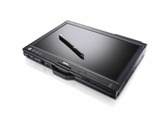Several folks are interested in the Latitude XT2 – Engadget, SlashGear, Gotta Be Mobile and others have written in anticipation of the coming launch of the Latitude XT2. Rather than making you all wait any longer, we’re unveiling the Latitude XT2 today (Tuesday) instead of tomorrow as speculated here. We hope you like what you see. Click on the image to the left to see a larger version of it. To see more pictures, go here on Dell’s Official Flickr page.
 To give a bit of historical perspective, a little more than a year ago Dell announced the first convertible tablet, the Latitude XT, with capacitive touch capability. Capacitive touch technology is really unique a couple of ways – it responds the human touch, does not require force for input and was the forerunner technology for multi-touch capabilities.
To give a bit of historical perspective, a little more than a year ago Dell announced the first convertible tablet, the Latitude XT, with capacitive touch capability. Capacitive touch technology is really unique a couple of ways – it responds the human touch, does not require force for input and was the forerunner technology for multi-touch capabilities.
Eight months later, we introduced a firmware update that unlocked multi-touch capabilities, making it the first convertible tablet of its kind. Today, we’re updating the Latitude XT2. This upgrade incorporates latest technologies to deliver better performance and enhanced security, plus improved manageability and connectivity:
- Up to 11 hours, 28 minutes of battery life with six-cell battery and optional six-cell battery slice.
- Improved connectivity with new LCD-based wireless antenna design.
- Enhanced hinge design for improved panel stability.
- SATA drive support providing updated storage technology and enhanced performance.
- Comprehensive security features adding Dell ControlVault and ControlPoint Security Manager.
- DDR3 RAM allows better performance and up to 5GB RAM.
- Manageability with integration of Intel vPro and DASH 1.0 compliance
We’re also enabling rotate as a multi-touch “gesture,” in addition to pan, rotate, scroll and zoom. These “gestures” work with common productivity applications like Microsoft Outlook and Internet Explorer, and features high touch accuracy for small icons.
You’ll notice some design changes too. We’ve relocated the WWAN antenna to the top of the screen for more convenience, as opposed to an external, pull-out antenna on the Latitude XT located next to the pen. And we’ve also added eSata that is also compatible with USB.
If you’re more the visual type, here’s a short video that highlights some of the capabilities of the Latitude XT2.